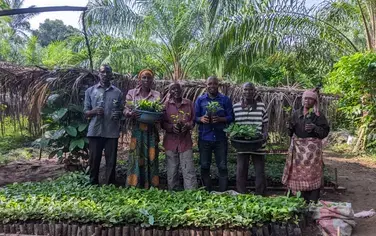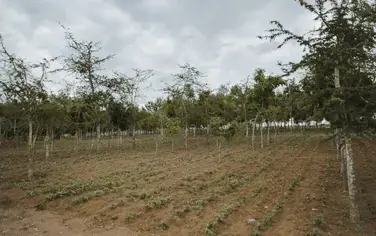- The pandemic has laid bare the weaknesses in our global food system.
- We must take this opportunity to rethink the way we produce, distribute and eat food in order to help build a healthier and more sustainable world.
- Here are three actions to kickstart the change process.
The COVID-19 crisis is a ‘stress test’ for our global food systems – and they are failing. Today we see farmers dumping milk and ploughing crops back into their fields, even as stores empty and the need for food assistance surges. We see export restrictions and price hikes as experts predict dramatic increases in malnutrition globally. These failures demand that we ask not only how to repair this damage, but how to fundamentally reimagine food systems to make them more nourishing, resilient and sustainable.
For decades, thinking and strategies around food have developed in silos, with little coordination between communities working on nutrition, agriculture, food, environment, water, health, climate, employment, trade or transport. This has generated serious problems – from policies that provide cheap calories but lead to high rates of diet-related diseases, to market innovations that prioritize efficiency above all and production systems that contribute to climate change and biodiversity loss.
The pandemic has shown that sectors that seem distinct do not operate independently. Though still being investigated, COVID-19 likely originated in wild animals sold in open food markets. The virus easily jumped to humans because farmers had cleared and settled large areas of natural habitat, increasing interactions of wildlife with people, including as food. Sanitary standards at markets were poorly regulated, while rapid transport between densely populated cities spread the virus globally. Now whether infected people become seriously ill or die depends on their underlying health and nutrition, as well as their access to healthcare, sanitation and adequate housing. Indeed, COVID-19 is a story of multiple systems impacting each other, triggering a host of unintended consequences impossible to understand, let alone manage, without looking at them together.
Reimagining and re-designing our food systems
Understanding the connections between these seemingly distinct domains is crucial to emerge stronger from the pandemic. Systems thinking – a way of understanding how interdependent structures interact in a dynamic system – can help.
Taking a systems view allows us to tackle complex questions, such as: How can food systems help eliminate diet-related disease? How can we ensure abundant harvests while sustaining natural habitats and healthy ecosystems? How can farmers adapt to and help fight climate change? How can marginalized consumers, workers and producers be empowered? How can we reduce vulnerabilities to future shocks?
Next year, world leaders and experts will convene for the Food Systems Summit of 2021, called for by the United Nations Secretary General, to articulate and adopt an actionable, integrated plan for food systems transformation. Looking ahead to the summit, we need to bring siloed communities together to redesign how we produce, process, distribute, regulate, legislate, research, cook and eat food.
This is ambitious, but we must be bold and think big. Drawing on systems thinking, we propose three initial actions to reimagine and redesign our food systems:
1. Re-think supply chains for a diverse and healthy diet. Food choices matter. If all humans shifted their diets to include more fruits, vegetables, seeds, nuts, fish and whole grains, we would see substantial reductions in diet-related disease, including heart disease, cancer, diabetes and stroke – many of which increase the risk of serious illness from COVID-19. Yet the global food system isn’t built for diverse, healthy diets: 80% of the world’s food supply is grain and grain-fed livestock, while fruit, vegetables, pulses and fish are expensive and much less accessible.
We must redesign supply chains with nutrition and human health in mind. We can begin by supporting local food systems with shorter, fairer and cleaner supply chains that address local priorities, while configuring national and global trade to promote diversity and reduce supply risks.
2. Build strong connections between environment and food policy. How farmers produce food determines not only the fertility of their soils, but the health of the planet. The food systems of tomorrow must embrace the One Health vision and advance positive interactions between human health, livestock health, wildlife health and ecosystem health. This approach can minimize the spread of disease, ensure adequate water for crop irrigation, reduce destructive flooding and wildfires, and protect farmlands from intense climate events, while also sustaining wild biodiversity and essential forest, grassland and wetland habitats. Farmers should be helped to diversify their incomes and incentivized to farm both productively and as environmental stewards.
In 2021, the global community will develop a new action framework for the UN Convention on Biological Diversity, advance action under the UN Framework Convention on Climate Change, and begin the UN Decade for Ecosystem Restoration. Sustainable food systems must be central to these strategies.
3. Strengthen, democratize and localize food systems planning. To approach food systems transformation holistically, policy-makers must democratize planning and invite all actors working in and alongside food systems – producers, businesses, social and environmental organizations, health workers, farmers, consumers, scientists and policy-makers – to be part of the effort. While national policy-makers can provide critical perspectives and frameworks for change, local and regional stakeholders must be able to shape their own food systems to reflect local values, resources and priorities.
EcoAgriculture Partners, for example, has documented nearly 500 large landscape partnerships in Africa, Latin America, Asia, Europe and the US, whose members are collaborating on long-term food system resilience and sustainable development. We need their perspectives at the upcoming Food Systems Summit.
Moving forward
The COVID-19 pandemic has revealed the vulnerabilities and failures of our food systems, and the urgent need to build back better. Visionaries around the world are already leading the way. The Rockefeller Foundation’s Food System Vision Prize received innovative ideas from 1,300 collaborative organizations focused on building food systems that integrate food, environment, health, culture, diets and technology. These ideas prove that we can build resilient food systems that sustain both human health and the health of our planet – and a systems approach will help us get there. We’ll be exploring those ideas during a virtual event on 24 June – we hope you will join us.
Now, we have a choice: to go back to the old “normal,” or to work together and emerge stronger. A nourishing, resilient and sustainable food future is within our grasp.




